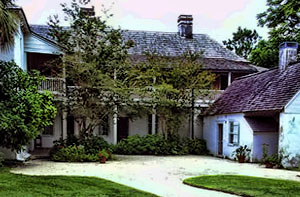Ximenez-Fatio House Museum
Welcome to the Ximenez-Fatio House Museum, one of St. Augustine’s most authentic historic properties. The museum complex is located on Aviles Street, America’s first platted thoroughfare, in the center of the city’s oldest community, the Old Town area South of the Plaza. The property includes a ca. 1798 coquina stone House, the region’s only detached Kitchen building, a reconstructed ca. 1802 Wash House and a new Visitor Center with state-of-the-art interactive exhibits and a Museum Store.
In 1939, The National Society of The Colonial Dames of America in The State of Florida (NSCDA-FL) acquired the property for use as its state museum house. The NSCDA-FL joined with the National Park Service, State of Florida, Carnegie Foundation and other groups to initiate St. Augustine’s historic preservation program.
Today the house stands as one of the best preserved of the three dozen colonial buildings remaining in St. Augustine. The historic grounds of the museum date to St. Augustine’s original town plan of 1572. Meticulous restoration and furnishings of period decorative arts and historical objects provide the setting for authentic portrayals of territorial life and early statehood in St. Augustine. The museum focuses on the property’s role as a boarding house, representing one of the few socially acceptable business ventures for a 19th century woman.
In July of 2002, shortly after beginning the 10th archaeological dig on the grounds at the Ximenez-Fatio House, an extraordinary small cross (pictured at left) was retrieved from the tens-of-thousands of items in a trash pit. Treatment removed a dark patina of encrusted salts to expose the resplendent white bronze material and fine details. Named for a hillside town in southeastern Spain, this Caravaca Cross is believed to have become popular in the 17th century to celebrate the end of the plague. St. Augustine City Archaeologist Carl Halbirt said, “I’ve never seen a cross like this one. They have been found in the Southeast, the Caribbean and in Canada, but not here — until now.”
Open:
Tuesday – Saturday, 11 a.m. – 4 p.m.
Last tour is at 3:30 p.m.


